Introduction
How do you choose healthy cherry shrimp for your aquarium? In this detailed guide, we will cover everything you need to know about selecting healthy cherry shrimp.
Whether you’re looking for tips on “how to pick healthy cherry shrimp” or a “healthy cherry shrimp buying guide,” this comprehensive resource will help you make the best choice.
From examining their appearance to considering the source, we’ll ensure you’re well-equipped to find vibrant, healthy cherry shrimp for your tank.
Examine Their Appearance
When choosing cherry shrimp, the first thing to look for is their appearance. Healthy shrimp should display several qualities:
Vibrant color: Cherry shrimp should have a bright red hue, although the intensity can vary depending on age, stress, and diet. Keep in mind that shrimp may lose some color during transportation but should regain their vibrancy in a suitable environment.
Clear body: Their bodies should be free of any visible parasites, injuries, or deformities. Use a magnifying glass to inspect the shrimp closely and ensure their legs, antennae, and rostrum (the beak-like projection on their head) are intact.
Size and age: Cherry shrimp can vary in size depending on their age. Juvenile shrimp will be smaller and might have less intense coloration, while adult shrimp will be larger and have more vibrant colors.
It’s essential to consider the age of the shrimp you’re selecting, as younger shrimp may adapt more easily to a new environment.
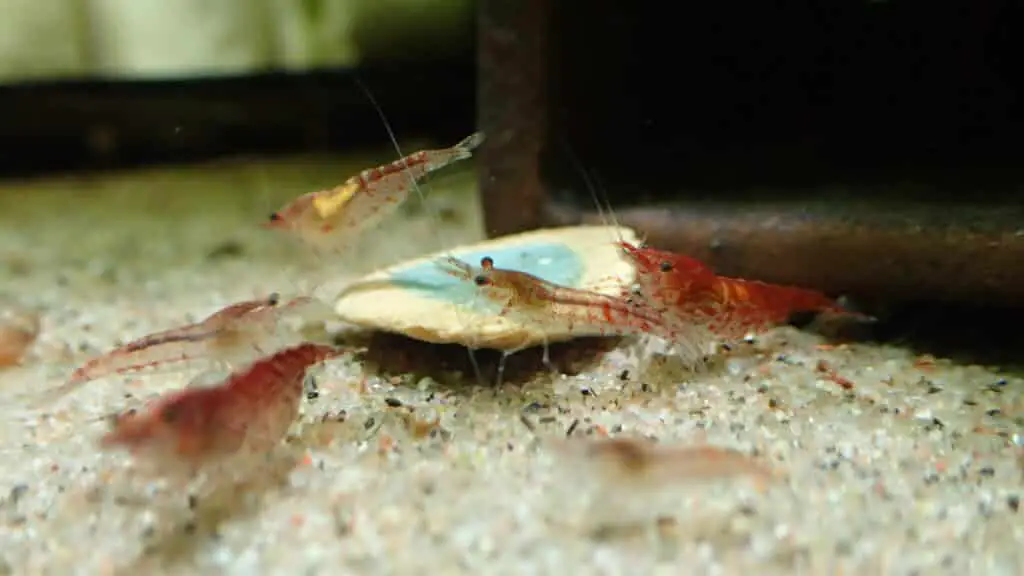
Check for Activity Levels
Healthy cherry shrimp should exhibit natural behaviors like actively swimming, foraging, grooming, and social interaction. When observing shrimp, look for the following signs:
Actively swimming: Shrimp should move around the tank, swimming in short bursts or crawling on surfaces.
Foraging and grooming: They should be actively picking at surfaces, searching for algae or biofilm to consume, and grooming themselves regularly.
Social interaction: Cherry shrimp are social creatures and should interact with other shrimp in the tank.
Avoid lethargic shrimp: Those that appear inactive, sluggish, or hiding constantly may be stressed or ill.
Assess the Tank Environment
Before purchasing cherry shrimp, examine the store or breeder’s tank to ensure the shrimp are living in a suitable environment:
Cleanliness: The tank should be clean and well-maintained, with no signs of algae overgrowth or uneaten food.
Dead or sickly inhabitants: If you notice dead or visibly unhealthy shrimp in the tank, it may indicate poor care or the presence of diseases. Look for another source in such cases.
Water parameters: Ask the store or breeder about the water parameters, ensuring they match the optimal conditions for cherry shrimp (pH 6.5-8.0, temperature 72-78°F, and gH 4-8 dGH).
Adequate hiding spaces: A proper tank should have ample hiding spaces, such as plants, driftwood, or other decorations, to reduce stress and promote natural behaviors among the shrimp.
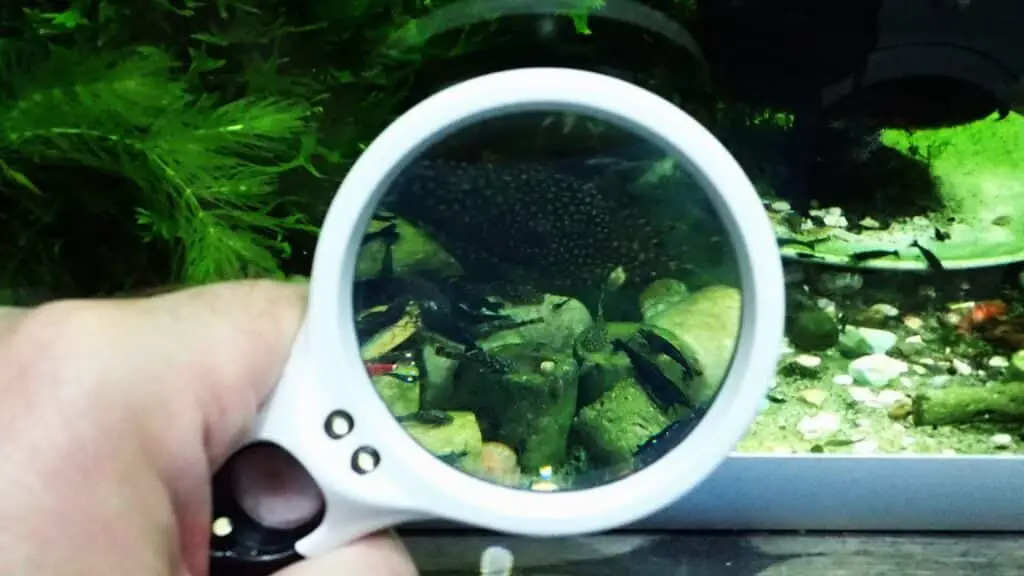
Bring a Magnifying Glass
A magnifying glass can be a helpful tool when selecting cherry shrimp, allowing you to:
Inspect shrimp closely: Use the magnifying glass to examine each shrimp’s body, legs, antennae, and rostrum for signs of health and potential issues.
Identify parasites or disease: A magnifying glass can help you spot parasites or other signs of illness that may not be visible to the naked eye.
Using Reading Glasses to Help You Choose Healthy Cherry Shrimp
Sometimes, using reading glasses can be an effective alternative to a magnifying glass when selecting cherry shrimp. To make the most of this option, follow these steps:
- Visit an optician: Schedule an appointment with an optician to determine the appropriate strength of reading glasses for your needs. They will assess your vision and recommend the right lens power to help you see objects up close clearly.
- Purchase reading glasses: After receiving a recommendation from the optician, purchase a pair of reading glasses suited to your vision requirements. Many stores carry a wide range of designs, so you can choose a pair that is comfortable and suits your personal style.
- Inspect shrimp closely: With your new reading glasses, you can closely examine cherry shrimp in a similar way as with a magnifying glass. Look for signs of vibrant color, clear bodies, and intact limbs while assessing the shrimp’s overall health.
- Compare with a magnifying glass: If you’re unsure about the effectiveness of your reading glasses, you can compare your observations with those made using a magnifying glass. This comparison will help you determine if your reading glasses provide sufficient magnification to inspect cherry shrimp effectively.
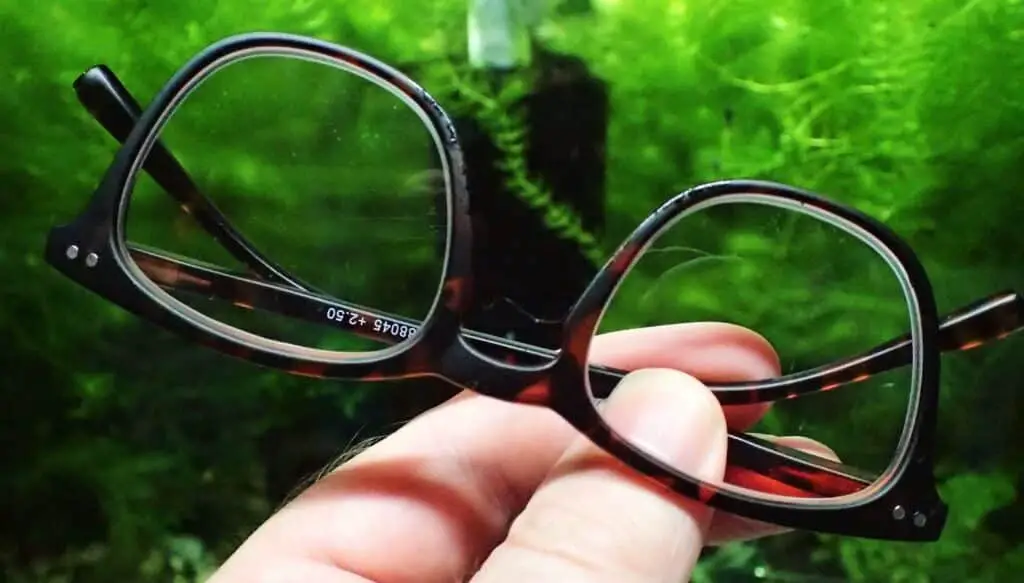
Top Tip: For an even closer inspection of cherry shrimp, combine the use of reading glasses and a magnifying glass.
This combination will provide enhanced magnification, allowing you to examine the shrimp’s appearance, coloration, and health more accurately before making your selection.
Remember to consult an optician to obtain the appropriate reading glasses for your vision needs.

Purchase from a Reputable Breeder or Store
Selecting cherry shrimp from a reliable source is crucial:
Research breeders and stores: Look for reviews, recommendations, or testimonials from other hobbyists to ensure you’re purchasing from a reliable source.
Ask about shrimp origin: Inquire about the source of the shrimp to determine if they were bred in-house or imported. Locally bred shrimp may be better acclimated to your water conditions.
Observe the breeder’s knowledge and care: The breeder or store staff should be knowledgeable about cherry shrimp care and able to answer your questions. Their interest in the well-being of the shrimp is a good indicator of the quality of their stock.
To determine if a breeder is reputable, consider the following steps:
- Research the breeder: Start by conducting an online search to gather information about the breeder. Look for their website, social media profiles, and any articles or reviews about their operation.
- Read customer reviews and testimonials: Check online forums, social media platforms, and review websites for feedback from customers who have previously purchased shrimp from the breeder. This can provide insight into the quality of their stock and their customer service.
- Ask for recommendations: Reach out to fellow aquarium hobbyists, local fish stores, or online communities for recommendations on reputable breeders. These sources can share their personal experiences and help you make an informed decision.
- Inquire about their breeding practices: Contact the breeder and ask questions about their breeding practices, including their approach to maintaining healthy shrimp, their water parameters, and their methods for preventing disease and parasites. A knowledgeable and transparent breeder is more likely to be reputable.
- Visit their facility (if possible): If the breeder is located nearby or if you have the opportunity to visit, observe the conditions of their breeding facility firsthand. Look for clean and well-maintained tanks, healthy shrimp, and appropriate water parameters.
- Assess their communication: A reputable breeder should be responsive to inquiries, willing to answer questions, and provide guidance on shrimp care. Good communication and a genuine interest in the well-being of their shrimp are positive indicators.
By following these steps, you can make an informed decision about whether a breeder is reputable.

Consider Shrimp Age and Size
When selecting shrimp, consider their age and size:
Young shrimp: Juvenile shrimp may have less intense coloration but will develop more vibrant hues as they grow. They may also be more adaptable to new environments and easier to introduce to an existing colony.
Adult shrimp: Adult shrimp display more intense coloration and are easier to sex, which is helpful if you want to establish a breeding colony. However, they may be less adaptable to new environments than juvenile shrimp.
Be Prepared to Quarantine
Quarantining new shrimp is crucial for ensuring the health of your existing aquatic pets:
Set up a quarantine tank: Before introducing new shrimp to your main tank, set up a separate quarantine tank with similar water parameters to observe the shrimp.
Quarantine period: Keep the new shrimp in the quarantine tank for at least two weeks, observing them for any signs of disease or parasites.
Treatment if necessary: If you notice any health issues during the quarantine period, treat the shrimp accordingly before introducing them to your main tank.
Pros and Cons of Buying Imported Shrimp
Imported shrimp can be an attractive option for hobbyists looking for rare or unique shrimp varieties. However, there are some pros and cons to consider:
Pros
- Availability: Imported shrimp can offer access to a wider variety of species and colors not commonly found in local pet stores.
- Cost: Imported shrimp can be cheaper than locally bred shrimp due to the lower cost of production in their country of origin.
Cons
- Shipping stress: Imported shrimp may experience stress during shipping, which can impact their overall health and make them less resilient to new environments.
- Parasites and disease: Imported shrimp may carry parasites or disease that local breeds have already developed a resistance to. Introducing imported shrimp without proper quarantine and treatment can lead to an outbreak in your tank.
- Need for quarantine: Imported shrimp should be quarantined for at least two weeks to monitor for any signs of disease or parasites before introducing them to the main tank.
Before purchasing imported shrimp, consider the pros and cons, and do your research on the breeder and their import process.
Proper quarantine and treatment can minimize the risks associated with introducing imported shrimp to your tank.
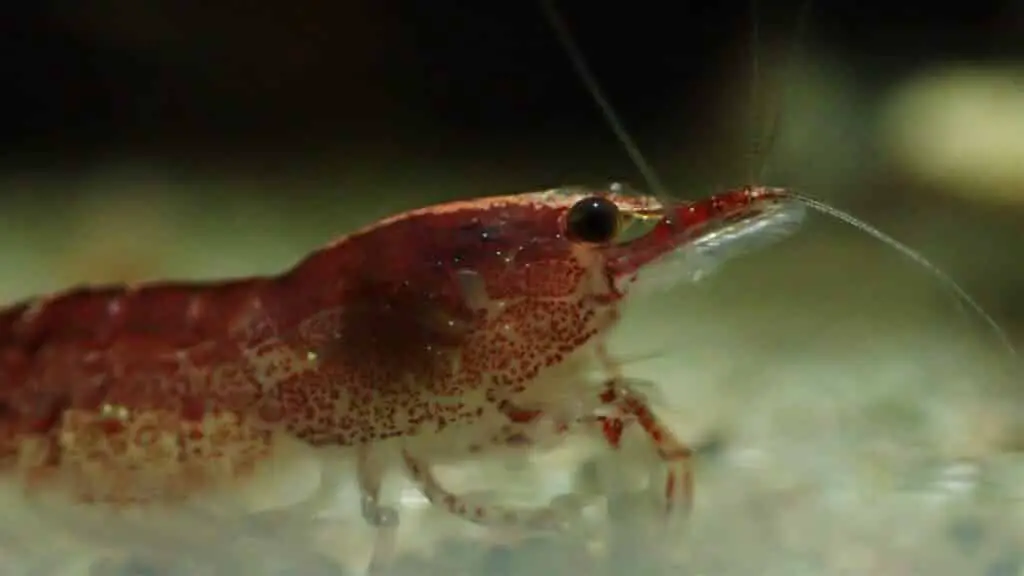
Pros and Cons of Buying Shrimp Locally
Buying shrimp locally can offer its own set of advantages and disadvantages:
Pros
- Convenience: Purchasing locally can save you time and money on shipping fees.
- Availability: Local pet stores may carry a wide variety of shrimp that are bred and acclimated to the local water conditions, making them a more stable and reliable option for your tank.
- Support local businesses: Supporting local pet stores or breeders can help bolster the local economy and provide a sense of community.
Cons
- Limited selection: Local pet stores may have a limited selection of shrimp varieties compared to online retailers or specialty breeders.
- Quality control: Local pet stores may not have the same level of quality control as specialty breeders, leading to possible issues with the health and genetics of their stock.
- Higher prices: Local pet stores may charge higher prices due to the added costs of operation and maintenance.
Before purchasing shrimp locally, consider the pros and cons, and do your research on the pet store or breeder to ensure that they are reputable and offer healthy stock.
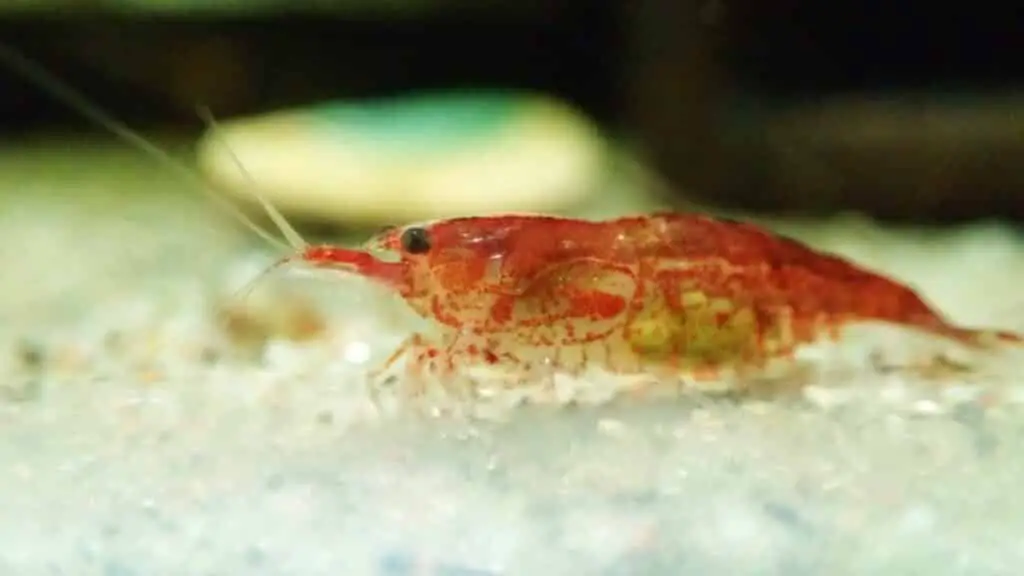
Summary Table For Choosing Healthy Cherry Shrimp
Key aspects to consider when choosing healthy cherry shrimp. Here’s an example:
| Aspect | Description |
|---|---|
| Appearance | Vibrant color, clear body, intact limbs, and age-appropriate size |
| Activity Levels | Actively swimming, foraging, grooming, and interacting with other shrimp |
| Tank Environment | Clean, well-maintained, appropriate water parameters, and adequate hiding spaces |
| Magnifying Glass/Reading Glasses | Use for close inspection of shrimp, identifying parasites or diseases |
| Reputable Breeder or Store | Research breeders/stores, inquire about shrimp origin, and assess their knowledge and care |
| Shrimp Age and Size | Consider the adaptability of young shrimp versus the coloration and sexing ease of adult shrimp |
| Molting Signs | Look for molted shells and successful molting without complications |
| Quarantine | Set up a quarantine tank, observe shrimp for at least two weeks, and treat health issues if necessary |

Ask the Breeder about Their DOA Policy Before You Buy Shrimp
When purchasing shrimp, it’s important to ask the breeder about their DOA policy. This policy outlines what happens if your shrimp arrive dead or dying in the shipping process, including late shipping.
As a buyer, you are not responsible for the shipping service the breeder uses, so be sure to ask all these questions in written form so you have a copy of the breeder’s reply.
Reputable breeders will typically offer a DOA guarantee, which may include a refund, replacement, or credit for future purchases.
Before purchasing from a breeder, ask them about their DOA policy and make sure you understand the terms and conditions.
Some policies may require you to provide photo or video evidence of the dead shrimp, while others may have specific time frames for reporting DOA shrimp.
It’s important to ask about the breeder’s shipping methods and packaging to minimize the risk of DOA shrimp.
Having a clear understanding of the breeder’s DOA policy can help you make an informed decision and give you peace of mind when purchasing shrimp.
Don’t hesitate to ask the breeder any questions you may have, and make sure you have a written record of their DOA policy and any other important details about the transaction.
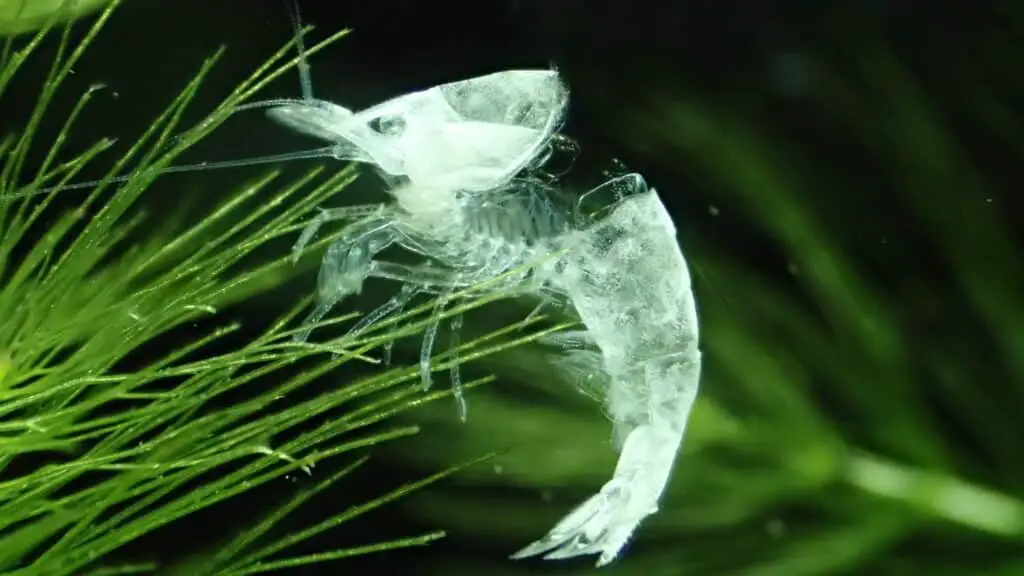
Conclusion
Choosing healthy cherry shrimp involves carefully examining their appearance, activity levels, and the environment they are kept in.
Utilize tools like a magnifying glass to inspect shrimp closely, and purchase from reputable breeders or stores. Be prepared to quarantine new shrimp and ensure that their age, size, and molting behaviors align with your goals for your aquarium.
By following these detailed guidelines, you will be well-equipped to select the healthiest cherry shrimp for your tank.
Frequently Asked Questions
Q: How do I choose healthy cherry shrimp?
A: Look for active and colorful shrimp with no signs of illness or injury. They should be swimming and exploring their environment. Using a magnifying glass or reading glasses can help you get a closer look at their appearance and behavior.
Q: How do I acclimate cherry shrimp to my tank?
A: To acclimate cherry shrimp to your tank, slowly drip acclimate them to your tank water by adding small amounts of your tank water to their shipping container over a period of a few hours. This allows them to adjust to the new water parameters without experiencing shock.
Q: What water parameters do cherry shrimp need to thrive?
A: Cherry shrimp prefer a pH range of 6.5 to 8.0 and a temperature range of 72 to 78°F. They also require clean water with low levels of ammonia and nitrite.
Q: How often should I feed my cherry shrimp?
A: Cherry shrimp are omnivores and can be fed a variety of foods, including algae, fish flakes , and pellets. Feed them small amounts once or twice a day, and remove any uneaten food after a few hours.
, and pellets. Feed them small amounts once or twice a day, and remove any uneaten food after a few hours.
Q: Can cherry shrimp live with other fish or invertebrates in my tank?
A: Cherry shrimp can live with other peaceful fish and invertebrates, but avoid keeping them with larger or aggressive fish that may eat or harm them.
Q: How do I breed cherry shrimp?
A: Breeding cherry shrimp requires a stable and healthy environment with plenty of hiding places and plants. They are prolific breeders and will produce offspring regularly under the right conditions.
Q: What are the most common diseases and illnesses that affect cherry shrimp?
A: The most common diseases and illnesses that affect cherry shrimp include bacterial infections, parasitic infections, and molting problems. Proper water quality and diet can help prevent these issues.
Q: How do I prevent parasites and diseases from spreading in my shrimp tank?
A: To prevent the spread of parasites and diseases, quarantine new shrimp for at least two weeks before introducing them to your main tank. Maintain good water quality, and avoid overfeeding and overcrowding.
Q: How often should I clean my shrimp tank?
A: Clean your shrimp tank regularly by performing partial water changes every one to two weeks and removing any debris or uneaten food. Avoid using chemical cleaners that can harm your shrimp.
Q: What plants are best for a cherry shrimp tank?
A: Cherry shrimp prefer planted tanks with plenty of hiding places and surfaces to graze on. Good plant choices include java moss, anubias, and hornwort.
